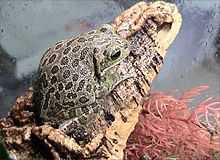Hyla gratiosa
| Barking tree frog | |
|---|---|
 | |
| Conservation status | |
| Scientific classification | |
| Kingdom: | Animalia |
| Phylum: | Chordata |
| Subphylum: | Vertebrata |
| Class: | Amphibia |
| Order: | Anura |
| Family: | Hylidae |
| Genus: | Hyla |
| Species: | H. gratiosa |
| Binomial name | |
| Hyla gratiosa LeConte, 1856 | |
The barking tree frog (Hyla gratiosa) is a species of tree frog endemic to the southeastern United States.
Geographic range
It is found from Delaware to southern Florida and eastern Louisiana, usually in coastal areas.
Description
Hyla gratiosa is the largest native tree frog in the United States. It is 5 to 7 cm (2.0 to 2.8 in) in head-body length. It is variable in color, but easily recognizable due to the characteristic dark, round markings on its dorsum. Individuals may be bright or dull green, brown, yellowish, or gray in color. It has prominent, round toe pads, and the male has a large vocal sac.
Behavior
The barking tree frog is known for its loud, strident, barking call. It may also utter a repetitive single-syllable mating call. It has been known to chorus with other frogs of the same and similar species.
The barking tree frog burrows in the sand, especially when the temperature is hot. It also spends time high up in trees, especially during the day when it is less active.
It breeds in shallow pools or ponds from March to August. It is a polygynous species, the female choosing the male on the basis of his call. Tadpoles can be nearly 5 cm (2.0 in) in length.
References
- ↑ Hammerson, G. 2004. Hyla gratiosa. In: IUCN 2012. IUCN Red List of Threatened Species. Version 2012.2. Downloaded on 04 June 2013.
External links
![]() Data related to Hyla gratiosa at Wikispecies
Data related to Hyla gratiosa at Wikispecies
![]() Media related to Hyla gratiosa at Wikimedia Commons
Media related to Hyla gratiosa at Wikimedia Commons
